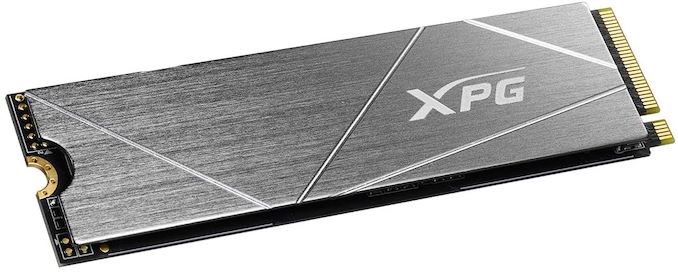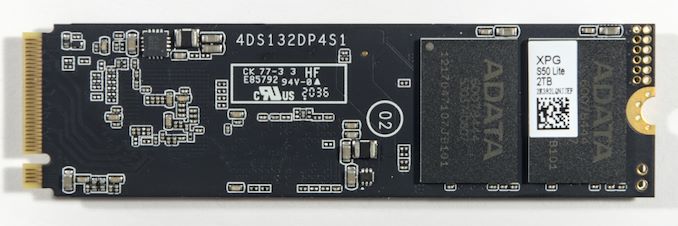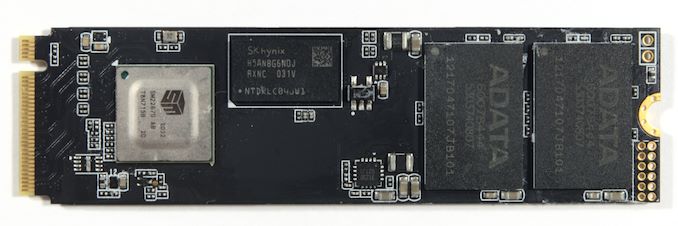The ADATA GAMMIX S50 Lite 2TB SSD Review: Mainstream PCIe Gen4
by Billy Tallis on April 30, 2021 8:00 AM EST
The roll-out of PCIe 4.0 support to consumer NVMe SSDs has been a long, drawn-out process so far, but it is progressing. Two waves of high-end SSDs have now hit the market, and last year we saw several brands introduce QLC-based SSDs using the now-outdated first-wave Gen4 SSD controller from Phison. More recently, PCIe 4.0 support has arrived for the mainstream mid-range market segment thanks to the ADATA XPG Gammix S50 Lite, based on the Silicon Motion SM2267 controller and TLC NAND flash memory.
The ADATA S50 Lite uses Silicon Motion's first PCie 4.0 SSD controller: the SM2267. Opting to start small, Silicon Motion has launched their mainstream SSD controller first, while their upcoming (overdue?) SM2264 will eventually be filling the high-end role.
To that end, the SM2267 serves Silicon Motion's lineup as a smaller, cheaper design aimed at mainstream consumer use cases. To accomplish this, Silicon Motion has built the SM2267 on a tried-and-true (and cheap) 28nm process and equipped the controller with 4 NAND channels, as opposed to the 12nm (or smaller) 8-channel controllers that are used in the latest high-end drives. This does limit maximum performance, but it also helps to keep costs in check, something that's especially useful during the current chip crunch.
Intel's recently-launched third generation QLC SSD (the Intel SSD 670p) uses a close relative of this controller; the SM2265 is an Intel-commissioned derivative of the SM2267 that lacks PCIe 4.0 support, but is otherwise identical in all the important ways. As we'll see from the S50 Lite's performance, the Intel 670p isn't missing out on much without that Gen4 support.
As for the subject of today's review, the ADATA XPG Gammix S50 Lite and its SM2267 controller is part of a growing trend of mainstream NVMe SSDs moving to 4-channel controllers rather than 8 channels. The capacity of individual NAND flash memory dies has grown to the point that an 8-channel controller is not necessary to get 2TB of flash connected, and the IO speed of recent generations of NAND flash is fast enough that a newer four-channel controller can match the performance of older 8-channel designs. This was first demonstrated to great effect by the SK hynix Gold P31. On paper, the Gammix S50 Lite promises more or less the same thing: performance that matches or slightly exceeds what we see from high-end PCIe Gen3 SSDs also using TLC NAND, despite working with half as many NAND channels.
| ADATA XPG Gammix S50 Lite Specifications | |||||
| Capacity | 512 GB | 1 TB | 2 TB | ||
| Form Factor | M.2 2280 double-sided with heatsink | ||||
| Interface | PCIe 4 x4, NVMe 1.4 | ||||
| Controller | Silicon Motion SM2267 | ||||
| NAND Flash | Intel/Micron 96L TLC | ||||
| DRAM | DDR4 | ||||
| Sequential Read (MB/s) | 3800 | 3900 | |||
| Sequential Write (MB/s) | 2800 | 3200 | |||
| Random Read IOPS (4kB) | 191k | 380k | 490k | ||
| Random Write IOPS (4kB) | 510k | 540k | |||
| Warranty | 5 years | ||||
| Write Endurance | 370 TB 0.4 DWPD |
740 TB 0.4 DWPD |
1480 TB 0.4 DWPD |
||
| Retail Price | $139.99 (14¢/GB) |
$235.99 (12¢/GB) |
|||
ADATA equips the S50 Lite with a fairly thick heatspreader, and like most of their Gammix SSDs, that heatspreader comes already attached to the drive rather than packaged separately as with their SX series drives. Instead of using their typical thermal paste, this heatspreader is attached with what is by far the most tenacious thermal tape we've ever encountered. It is reinforced with a tight-woven stiff fabric and the adhesive was strong enough that removing the heatspreader without permanently damaging the drive required copious use of solvents instead of just a bit of gentle prying.
So while we had originally speculated that the SM2267 controller might allow the S50 Lite to be the first Gen4 SSD suitable for laptop usage (hoping for similar power efficiency to the SK hynix Gold P31), this heatspreader plus the double-sided design means the S50 Lite will be a challenge to fit into some notebooks.
The SM2267 controller actually has a slightly higher pin count than the older 8-channel SM2262(EN) controllers, but the SM2267 uses denser packaging to fit in the same footprint as their earlier 4-channel SM2263 controller. The resulting PCB layout is not at all crowded, and could have easily been made into a single-sided design like the Intel 670p, had ADATA wanted to stack 16 NAND dies per package. Any future drives that use the DRAMless SM2267XT variant certainly should be single-sided.
Our 2TB S50 Lite sample is equipped with 1GB of DDR4 DRAM—half as much as we would typically expect from a mainstream or high-end SSD. As the high-end has moved on to PCIe Gen4, we have seen an increasing number of mid-range or low-end NVMe SSDs cut back from the usual 1GB per 1TB ratio of DRAM to NAND, and with the S50 Lite that trend has crossed over to Gen4. Having half or a fourth of the usual DRAM is nowhere near as serious a handicap as an entirely DRAMless SSD design, and will generally only make a difference for very storage-intense usage with heavy multitasking—workloads that are a bit beyond the intended use case for a drive like the S50 Lite.
Also noteworthy about the S50 Lite is that ADATA announced and published specs for a 512GB model, but we've only seen the 1TB and 2TB models hit the market.
The Competition
ADATA's original Gammix S50 was a Phison E16 drive: their first flagship Gen4 drive and part of the first wave of consumer Gen4 SSDs. That has since been superseded by the Gammix S70, and the S50 Lite slots into a lower position in their product stack. Standing in for the various Phison E16 TLC drives, we have test results from the Seagate FireCuda 520. We also have the Corsair MP600 CORE representing the Phison E16 QLC drive family.
Other PCIe Gen4 drives in this review include the WD Black SN850 and Samsung 980 PRO—both high-end models that are significantly more expensive.
The rest of the drives included in this review are a variety of more mainstream PCIe Gen3 SSDs and some relatively low-end NVMe options. Highlights include the Intel 670p (almost the same controller, but with QLC), the HP EX950 and Kingston KC2500 using the previous-generation SM2262EN controller, and Microcenter's Inland Premium representing the current crop of Phison E12S drives with TLC NAND and a reduced DRAM ratio.

















93 Comments
View All Comments
utmode - Sunday, May 2, 2021 - link
@Billy Tallis, is there any recent research done on data retention on QLC drive. Electrons are very naughty at staying at a set voltage.Billy Tallis - Sunday, May 2, 2021 - link
Write endurance limits are set based on how much you can wear out the flash and still have one year of unpowered data retention (or three months for enterprise drives). That's still largely determined with high-temperature accelerated testing, but it's pretty well understood how to do that properly.bansheexyz - Saturday, May 1, 2021 - link
Can we ban this idiot already? A 10TB QLC drive will have a larger write endurance than a 2TB TLC drive does today. There is nothing inherently wrong with QLC tech, its supposedly inferior write endurance is self-mitigating by the fact that there are more cells to spread writes across. Which is exactly why TLC overtook MLC, and MLC overtook SLC. Go the frick away.GeoffreyA - Sunday, May 2, 2021 - link
Not a fan of freedom of speech/expression/press? Especially when it comes to these money-driven corporations, one needs to put whatever they do under a microscope and pay little heed to their words.There's nothing wrong with QLC. It's a product with a place: supposedly, bigger size and cheaper price. (Concerning endurance, if the ratings are true and not made up, they ought to be fine for most people.) But as far as I can see, QLC isn't *that* much cheaper than TLC. About 15-20% or something to that effect. Costly to make, greed, the pandemic, or all three?
futrtrubl - Sunday, May 2, 2021 - link
That's pretty much what it should be. QLC holds about 33% more than TLC, or, for the same amount of storage QLC uses 25% fewer cells. It's a less mature tech so I wouldn't expect it to get the full 25% savings, and all the other common components will reduce savings too.MFinn3333 - Sunday, May 2, 2021 - link
It is 50% more, not 33%.If you look at the total number states of a TLC which is 8 or 3 bit cells versus a QLC which is 16 states or 4 bit cells.
Billy Tallis - Sunday, May 2, 2021 - link
Voltage states are an enumeration of possibilities; they do not occupy physical space and are not the correct quantity to compare when discussing storage capacity.FunBunny2 - Monday, May 3, 2021 - link
"Voltage states are an enumeration of possibilities; they do not occupy physical space"well... would you deny that a larger cell, i.e. one with more atoms, is more capable of storing more distinct voltages with some delta of accuracy? not to mention the whole endurance thingee. IOW, as an applied physics problem, QLC is closer to the razor's edge of performance than lower xLC cells. were all this not true, then manufacturers have been wasting gobs and gobs of moolah to implement stacks of 'olde' larger node NAND for TLC and QLC.
Tamdrik - Sunday, May 2, 2021 - link
But most people don't measure their storage devices by how many different states they can maintain-- they measure them by how many bits (or xxx-bytes) they can store. By that (standard) measure, futrtrubl is correct in that a QLC drive holds 33% more data than a TLC drive with the same number of cells (4 bits per cell vs. 3 bits per cell), and if costs are the same per cell, would be expected to cost 25% less for a given capacity (e.g., 1 TB).Oxford Guy - Sunday, May 9, 2021 - link
'But most people don't measure their storage devices by how many different states they can maintain-- they measure them by how many bits (or xxx-bytes) they can store.'You really think that's a logically-sound rebuttal?